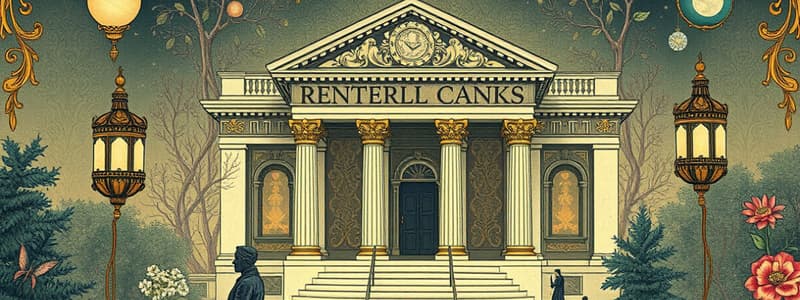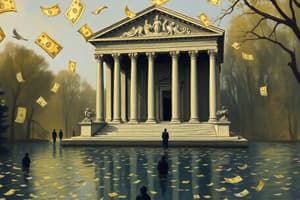Podcast
Questions and Answers
What is a requirement for an object to be used as money?
What is a requirement for an object to be used as money?
- It should be easily recognizable. (correct)
- It needs to be large in size.
- It must be expensive to produce.
- It must be aesthetically pleasing.
Which of the following best describes the function of 'unit of account' in money?
Which of the following best describes the function of 'unit of account' in money?
- It helps facilitate barter transactions.
- It enables the storage of wealth over time.
- It serves as a method of international trade.
- It allows for accurate pricing of goods and services. (correct)
Why is barter not suitable for modern economies?
Why is barter not suitable for modern economies?
- Barter involves illegal goods exchange.
- It relies on a double coincidence of wants. (correct)
- It can be done over the internet.
- Barter requires extensive government regulation.
What indicates that money must be durable?
What indicates that money must be durable?
Which characteristic of money ensures that it can be used in smaller transactions?
Which characteristic of money ensures that it can be used in smaller transactions?
What key factor determines the value of currency?
What key factor determines the value of currency?
Which function of money allows individuals to compare the value of different goods?
Which function of money allows individuals to compare the value of different goods?
Which item is considered a medium of exchange?
Which item is considered a medium of exchange?
What is the role of credit cards in relation to money?
What is the role of credit cards in relation to money?
Which of the following statements about inflation is correct?
Which of the following statements about inflation is correct?
Flashcards are hidden until you start studying
Study Notes
Money and Its Definition
- Money is anything widely accepted in exchange for goods and services.
- Barter involves the direct exchange of goods, requiring a double coincidence of wants, which is inefficient in modern economies.
Requirements of Money
- General acceptability: Must be desired and recognized as acceptable for exchanges.
- Durability: Should withstand frequent handling without wear.
- Manageability: Must be portable, with a mass relative to its value.
- Homogeneity and divisibility: Uniform appearance and divisible into smaller units.
- Recognisability: Easily identifiable and distinguishable from other items.
- Value: Must be scarce and maintain a relatively stable purchasing power.
Functions of Money
- Medium of exchange: Universally accepted for transactions.
- Unit of account: Prices of goods expressed in money, enabling value comparison.
- Store of value: Holds wealth over time; alternatives include gold and stocks.
- Standard of deferred payment: Assures stable purchasing power for credit transactions.
Types and Payment Methods
- Types of money include cash, debit cards, credit cards, and digital payment methods.
- Debit cards transfer money electronically; credit cards signify available credit, not actual money.
- Cheques serve as payment instruments transferring money between accounts.
Central Bank Functions
- The Bank of Namibia (BoN) is the country’s central bank, acting as a banker for the government.
- Manages the banking system and updates it with technological advancements.
- Acts as a custodian of bank reserves and serves as the lender of last resort.
Functions of the Bank of Namibia
- Facilitates inter-bank clearing and settlement processes.
- Sole authority to issue national currency (notes and coins).
- Manages official reserves, including gold and foreign currency.
- Implements monetary and exchange rate policy, coordinating with the South African Reserve Bank (SARB).
Money Creation Process
- Banks create money through lending processes stimulated by deposits.
- The credit multiplier indicates how much money can be generated from an initial deposit.
- Example: A deposit of N$1,000 with a reserve requirement of 20% can generate a total of N$5,000.
The Multiplier Effect
- The multiplier's size is influenced by the cash reserve requirement: a higher reserve means a smaller multiplier.
- An increased reserve requirement results in a reduced ability to create money.
- The multiplier is calculated as 1 divided by the reserve requirement ratio.
Monetary Policy Instruments
- Restrictive policy: Raising reserve requirements limits money creation and decreases the money supply.
- Expansionary policy: Lowering reserve requirements enhances money creation potential and increases the money supply.
Open Market Operations
- Central banks buy and sell government securities to modify bank liquidity, money supply, and interest rates.
- Selling securities reduces banks' reserves, constraining their loan abilities.
- Buying securities boosts bank reserves, enabling more loans and increasing the money supply.
Studying That Suits You
Use AI to generate personalized quizzes and flashcards to suit your learning preferences.




